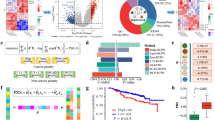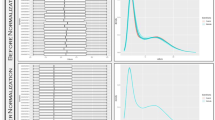Abstract
Background
Increasing the survival rates for breast cancer has gained significant researcher interest. However, current studies reveal that a small subset of gene makers can predict survivability for people with different breast cancer subtypes. In these studies, the selected genes are not necessarily functionally related, and hence, they may not correctly indicate the molecular mechanism behind breast cancer survivability. Also, several studies have shown there is a very low overlap between the biomarkers subsets for the same cancer disease. To improve the robustness of the classification performance and stability of detected biomarkers, recent methods involve taking existing knowledge on relations between genes into account in the classifier by aggregating functionality-related genes to produce discriminative gene subnetworks called network biomarkers.
Results
In this paper, using a dataset of patients with different subtypes of breast cancer, we devised a novel network-based approach by integrating a protein–protein interaction (PPI) network with gene expression data to (1) identify the network biomarkers (metagene) of breast cancer survivability and (2) predict the survivability of breast cancer patients based on their subtypes of breast cancer. Our method involves using the concept of seed genes for the identification of network biomarkers, ADASYN to solve class-imbalance, and random forest to predict the survivability of patients. We obtained the best classification performance with distance three from seed gene protein where the Gmean, F1-measure, and accuracy were respectively 0.900, 0.800, and 90.34%. The maximum size of a network biomarker with distance 3 is 9. A maximum of 34 genes is needed to accurately predict the survivability of breast cancer patients.
Conclusion
This method can be used to identify the survivability of breast cancer patients using gene relationship networks. It has high prediction performance, including specificity and sensitivity for both cohorts of survivals and deceased.





Similar content being viewed by others
References
Abou Tabl A, Alkhateeb A, ElMaraghy W, Rueda L, Ngom A (2019) A machine learning approach for identifying gene biomarkers guiding the treatment of breast cancer. Front Genet 10:256
Allahyar A, de Ridder J (2015) Feral: network-based classifier with application to breast cancer outcome prediction. Bioinformatics 31(12):i311–i319
Breiman L (2001) Random forests. Mach Learn 45(1):5–32
Carey LA, Claire Dees E, Sawyer L, Gatti L, Moore DT, Collichio F, Ollila DW, Sartor CI, Graham ML, Perou CM (2007) The triple negative paradox: primary tumor chemosensitivity of breast cancer subtypes. Clin Cancer Res 13(8):2329–2334
Chawla NV, Bowyer KW, Hall LO, Philip Kegelmeyer W (2002) Smote: synthetic minority over-sampling technique. J Artif Intell Res 16:321–357
Chuang H-Y, Lee E, Liu Y-T, Lee D, Ideker T (2007) Network-based classification of breast cancer metastasis. Mol Syst Biol 3(1):140
Curtis C, Shah SP, Chin S-F, Turashvili G, Rueda OM, Dunning MJ, Speed D, Lynch AG, Samarajiwa S, Yuan Y et al (2012) The genomic and transcriptomic architecture of 2,000 breast tumours reveals novel subgroups. Nature 486(7403):346–352
Dao P, Wang K, Collins C, Ester M, Lapuk A, Cenk Sahinalp S (2011) Optimally discriminative subnetwork markers predict response to chemotherapy. Bioinformatics 27(13):i205–i213
Dawson S-J, Rueda OM, Aparicio S, Caldas C (2013) A new genome-driven integrated classification of breast cancer and its implications. EMBO J 32(5):617–628
Duojiao W, Rice CM, Wang X (2012) Cancer bioinformatics: a new approach to systems clinical medicine. BMC Bioinf 13(1):71
Fabregat A, Sidiropoulos K, Viteri G, Forner O, Marin-Garcia P, Arnau V, D’Eustachio P, Stein L, Hermjakob H (2017) Reactome pathway analysis: a high-performance in-memory approach. BMC Bioinf 18(1):142
Fraser Symmans W, Liu J, Knowles DM, Inghirami G (1995) Breast cancer heterogeneity: evaluation of clonality in primary and metastatic lesions. Hum Pathol 26(2):210–216
Glass K, Quackenbush J, Spentzos D, Haibe-Kains B, Yuan G-C (2015) A network model for angiogenesis in ovarian cancer. BMC Bioinf 16(1):115
Greenman C, Stephens P, Smith R, Dalgliesh GL, Hunter C, Bignell G, Davies H, Teague J, Butler A, Stevens C et al (2007) Patterns of somatic mutation in human cancer genomes. Nature 446(7132):153–158
Hahn Milton E, MacLean Malcolm S (1955) Prognosis and prediction
Hanahan D, Weinberg RA (2011) Hallmarks of cancer: the next generation. Cell 144(5):646–674
He H, Bai Y, Garcia EA, Li S (2008) Adasyn: Adaptive synthetic sampling approach for imbalanced learning. In: Neural Networks, 2008. IJCNN 2008. (IEEE World Congress on Computational Intelligence). IEEE International Joint Conference on, pp 1322–1328. IEEE
Khoshgoftaar TM, Seiffert C, Van Hulse J, Napolitano A, Folleco A (2007) Learning with limited minority class data. In: Machine learning and applications, ICMLA 2
Kibbe WA, Arze C, Felix V, Mitraka E, Bolton E, Fu G, Mungall CJ, Binder JX, Malone J, Vasant D et al (2015) Disease ontology 2015 update: an expanded and updated database of human diseases for linking biomedical knowledge through disease data. Nucleic Acids Res 43(D1):D1071–D1078
Kim JH, Lee JM, Nam HJ, Choi HJ, Yang JW, Lee JS, Kim MH, Kim S-I, Chung CH, Kim KI et al (2007) Sumoylation of pontin chromatin-remodeling complex reveals a signal integration code in prostate cancer cells. Proc Nat Acad Sci 104(52):20793–20798
Lamond NWD, Skedgel C, Younis T (2013) Is the 21-gene recurrence score a cost-effective assay in endocrine-sensitive node-negative breast cancer? Expert Rev Pharmacoecon Outcomes Res 13(2):243–250
Lee E, Chuang H-Y, Kim J-W, Ideker T, Lee D (2008) Inferring pathway activity toward precise disease classification. PLoS Comput Biol 4(11):e1000217
Milioli HH, Vimieiro R, Riveros C, Tishchenko I, Berretta R, Moscato P (2015) The discovery of novel biomarkers improves breast cancer intrinsic subtype prediction and reconciles the labels in the metabric data set. PLoS One 10(7):e0129711
Mucaki EJ, Baranova K, Pham HQ, Rezaeian I, Angelov D, Ngom A, Rueda L, Rogan PK (2016) Predicting outcomes of hormone and chemotherapy in the molecular taxonomy of breast cancer international consortium (metabric) study by biochemically-inspired machine learning. F1000Research, vol. 5
Network CGA et al (2012) Comprehensive molecular portraits of human breast tumors. Nature 490(7418):61
Rouzier R, Perou CM, Fraser Symmans W, Ibrahim N, Cristofanilli M, Anderson K, Hess KR, Stec J, Ayers M, Wagner P et al (2005) Breast cancer molecular subtypes respond differently to preoperative chemotherapy. Clin Cancer Res 11(16):5678–5685
Sawyers CL (2008) The cancer biomarker problem. Nature 452(7187):548–552
Schneider JE, Sidhu MK, Doucet C, Kiss N, Ohsfeldt RL, Chalfin D (2012) Economics of cancer biomarkers. Person Med 9(8):829–837
Sheeba JDJ, Mohan C, Marine H, Gauri D, Neeraj K, Mukund LA (2016) Estrogen-regulated extracellular matrix remodeling genes in mcf-7 breast cancer cells. Gene Rep 3:14–21
Soneson C, Gerster S, Delorenzi M (2014) Batch effect confounding leads to strong bias in performance estimates obtained by cross-validation. PLoS One 9(6):e100335
Tabl Ashraf Abou, Alkhateeb Abedalrhman, Rueda Luis, ElMaraghy Waguih, Ngom Alioune (2018) Identification of the treatment survivability gene biomarkers of breast cancer patients via a tree-based approach. In: International conference on bioinformatics and biomedical engineering. Springer, Berlin, pp 166–176
Umetani N, Giuliano AE, Hiramatsu SH, Amersi F, Nakagawa T, Martino S, Hoon DSB (2006) Prediction of breast tumor progression by integrity of free circulating dna in serum. J Clin Oncol 24(26):4270–4276
van den Akker E, Verbruggen B, Heijmans B, Beekman M, Kok J, Slagboom E, Reinders M (2011) Integrating protein-protein interaction networks with gene-gene co-expression networks improves gene signatures for classifying breast cancer metastasis. J Integr Bioinf (JIB) 8(2):222–238
Verma M, Manne U (2006) Genetic and epigenetic biomarkers in cancer diagnosis and identifying high risk populations. Crit Rev Oncol Hematol 60(1):9–18
Vogelstein B, Papadopoulos N, Velculescu VE, Zhou S, Diaz LA, Kinzler KW (2013) Cancer genome landscapes. Science 339(6127):1546–1558
Wang W-J, Li Q-Q, Xu J-D, Cao X-X, Li H-X, Tang F, Chen Q, Yang J-M, Xu Z-D, Liu X-P (2008) Interaction between cd147 and p-glycoprotein and their regulation by ubiquitination in breast cancer cells. Chemotherapy 54(4):291–301
Wood LD, Williams Parsons D, Jones S, Lin J, Sjöblom T, Leary RJ, Shen D, Boca SM, Barber T, Ptak J et al (2007) The genomic landscapes of human breast and colorectal cancers. Science 318(5853):1108–1113
Xiang Y, Zhang J, Huang K (2013) Mining the tissue-tissue gene co-expression network for tumor microenvironment study and biomarker prediction. BMC Genom 14(S5):S4
Yamashita D, Moriuchi T, Osumi T, Hirose F (2016) Transcription factor hdref is a novel sumo e3 ligase of mi2\(\alpha\). J Biol Chem 291(22):11619–11634
Funding
The author(s) disclosed receipt of the following financial support for the research, authorship, and/or publication of this article: This work has been partially supported by the Natural Sciences and Engineering Research Council of Canada (NSERC), and the Windsor Essex County Cancer Centre Foundation (WECCCF) Seeds4Hope program.
Author information
Authors and Affiliations
Contributions
S. Jubair has collected the data and implemented the method, A. Ngom and L. Rueda have supervised him during the implementation. A. Alkhateeb helped in extending the method and in validating the results. A. Abou Tabl helped in validating the results. All authors have contributed equally in brainstorming and writing the manuscript.
Corresponding author
Ethics declarations
Conflict of interest
The authors declare that they have no competing interests.
Availability of data and material
The datasets analysed during the current study are available in the cBioPortal repository at http://www.cbioportal.org/study?id=brca_metabric. The resulting PPI network is included in the following link: Supplementary materials: http://www.luisrueda.myweb.cs.uwindsor.ca/datasets/Survivability-Network-Biomarkers-Data.zip. https://1drv.ms/u/s!AuOTsM1T2FzWhpFD_2mMNgkKZBoxng?e=f5cYzu.
Additional information
Publisher's Note
Springer Nature remains neutral with regard to jurisdictional claims in published maps and institutional affiliations.
Rights and permissions
About this article
Cite this article
Jubair, S., Alkhateeb, A., Tabl, A.A. et al. A novel approach to identify subtype-specific network biomarkers of breast cancer survivability. Netw Model Anal Health Inform Bioinforma 9, 43 (2020). https://doi.org/10.1007/s13721-020-00249-4
Received:
Revised:
Accepted:
Published:
DOI: https://doi.org/10.1007/s13721-020-00249-4




